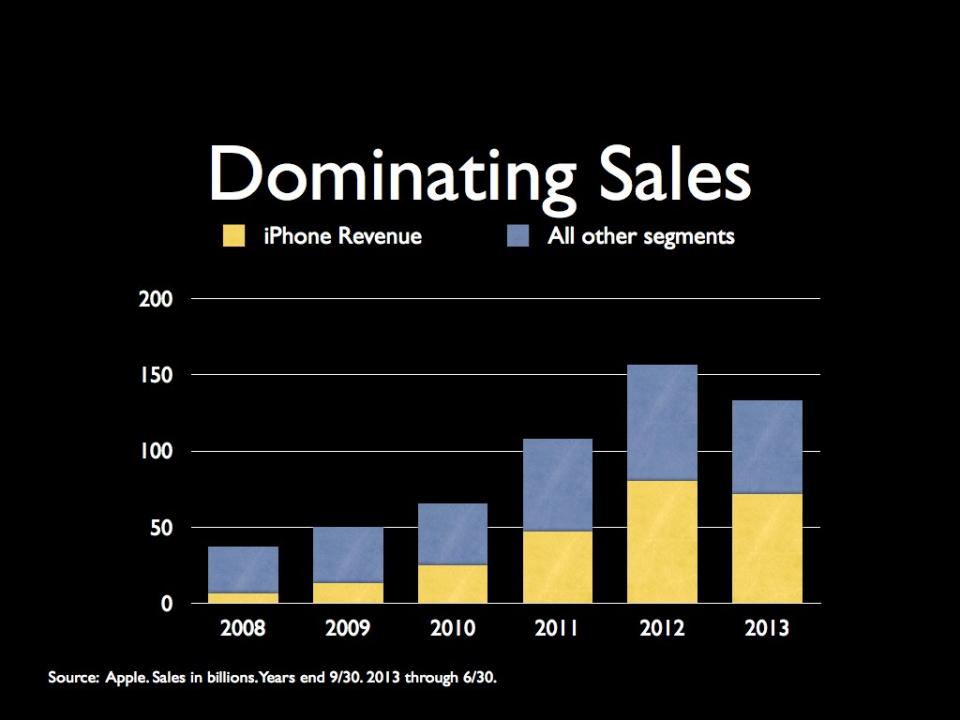Apple’s Most Important New Product Isn’t a Wristwatch

Rumor has it that Apple (AAPL) is working on a television set, a wristwatch and even its own cable TV service.
But the most important product in Apple’s stable this year is the same one that’s been critical to the company’s success for the past five years – the iPhone.
Since its introduction in 2007, the iPhone has grown rapidly to dominate sales at the company that started out making Macintosh computers and grew huge with the iPod music player.
So far this year, 54 cents out of every dollar of sales brought in by Apple has come via the iPhone – and analysts say the smartphone brings in an even greater proportion of profits.

But now iPhone sales growth is slowing. For the past nine months, sales have gained just 16% — versus a 71% jump in 2012 and gains of around 90% in prior years.
One problem is that Apple hasn’t updated its star product since the iPhone 5 launched last September, a 10-month eternity in the world of smartphones. And to try to entice bargain shoppers, Apple is offering the iPhone 4, a phone that debuted in 2010.
“It’s a company driven by new product cycles that hasn’t had any new products,” says Josh Spencer, manager of the T. Rowe Price Global Technology Fund. Apple was the fund’s top holding at the end of June.
Slower iPhone sales growth and the accompanying slip in profits are a big reason why Apple’s stock plummeted from a record $705.07 last September to under $450 currently. Apple clearly bungled some of its product introductions last year, cramming too many new offerings into the last few months of the year. The iPhone 5 went on sale in late September, a revised 4th generation iPad and new iPad mini arrived in stores in early November, and a revamped iMac desktop computer lineup hit at the end of November.
Sales were strong but time before the holidays was short – Apple CEO Tim Cook later admitted the company couldn’t make as many iPhones, iPads or iMacs as customers wanted to buy, resulting in lost sales.
“They’ve got to get off this fall schedule,” says Spencer. “It strains the organization and creates too much pent-up demand.”
Another problem is that an awful lot of people in major, developed markets such as the United States and Europe already have a smartphone. Phone makers shipped 120 million smartphones to U.S. consumers last year, up just 14% from 2011 after years of 50% or greater growth rates, according to IDC.
Sales are growing fastest in developing parts of the world – areas where Apple’s iPhone line looks mighty expensive. That’s why investors are hoping there’s some truth in the rumor that Apple is perfecting a lower-cost iPhone, perhaps with colorful, plastic cases. The rumor gained added momentum Monday when a watchdog group’s report about poor working conditions in a plant run by Apple contract manufacturer Pegatron mentioned plastic iPhone casings – all the current models are cased in metal.
A brand-new phone would likely appeal to many more customers – and could be designed with a higher profit margin than the old iPhone 4, analysts said.
“They’re forcing some customers who want Apple products and the Apple ecosystem to buy a two-year-old phone,” says Colin Gillis, analyst at BGC Partners. “The most important thing they need is definitely a lower-cost iPhone.”
In India, for example, the smartphone market is growing more than 50% a year and is in its early stages; more than 9 out 10 Indian mobile subscribers still use simpler-feature phones. Apple has only 3% share of the phone market there. And that’s after a rebate and trade in promotion last quarter boosted sales by 400% - especially of the iPhone 4. Typically sold for 26,500 Rupee, or about $447, the promotions cut the price to under 20,000 Rupee, or $337, according to the New Dehli Television network’s website.
Apple CEO Tim Cook crowed about the sales increase on last week’s quarterly earnings call with analysts. But he didn’t mention Apple’s small market share.
A cheaper iPhone sold in an array of colors could do far more to boost sales in developing regions. “The big product in the second half of 2013 will be the low-cost iPhone to drive iPhone adoption internationally where Apple’s market share is less than half of what it is in the U.S.,” says ISI Group analyst Brian Marshall.
Apple will have to design the low cost iPhone carefully to keep profit margins high and avoid sullying its premium brand cachet with wealthier consumers. Some analysts fear a low cost iPhone could never bring in enough profit to make the venture worthwhile.
And some analysts are holding hope for a brand new killer category entry from Apple. An Apple-branded television set could help get Apple back in investors’ favor, says John Bright, an analyst at Avondale Partners. Expanding the popular iTunes payment system to other merchants would also get investors excited, he says.
“An innovative new product or service category that has the potential to move the financial needle has the best chance to move the stock up," Bright says.
Most investors would probably agree – as long as a new iPhone came first.
To keep up with all the latest tech industry news, follow Aaron Pressman on Twitter and Tumblr.
